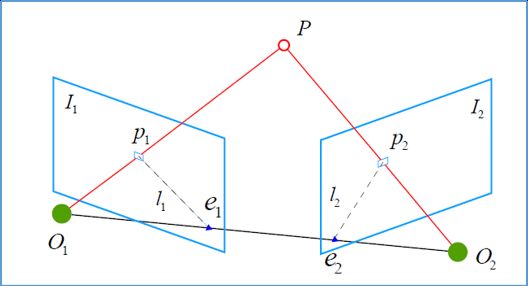10_视觉里程计1_三角测量
前言
通过上一节的介绍,我们可以计算出相机的运动,但是我们不知道特征点在空间中具体的位置。在单目SLAM中,仅依赖单张的图像我们是无法获取到像素的深度信息,我们需要通过三角化的方法来估计地图点的深度。
三角测量
三角测量是指,通过不同位置对同一个路标点进行观察,从观察到的位置推断路标点的距离。如图所示:
在最理想情况下, O 1 P 1 O_{1} P_{1} O1P1与 O 2 P 2 O_{2} P_{2} O2P2它们相交于 P P P,但是由于噪声的存在,这两直线往往无法进行相交。我们可以通过最小二乘的方法进行求解。由对极几何中的定义,我们设 x 1 x_{1} x1, x 2 x_{2} x2为两个特征点的归一化坐标,则有:
s 2 x 2 = s 1 R x 1 + t . s_{2} {x}_{2}=s_{1} {R} {x}_{1}+{t}. s2x2=s1Rx1+t.
现在我们已知 R R R, t t t, x 1 x_{1} x1, x 2 x_{2} x2,我们想要求解 s 1 s_{1} s1, s 2 s_{2} s2。我们可以这样,比如我们想要求解 s 1 s_{1} s1,可以两边左乘 x 2 ∧ x_{2}^{\wedge} x2∧,,则有:
s 2 x 2 ∧ x 2 = 0 = s 1 x 2 ∧ R x 1 + x 2 ∧ t s_{2} {x}_{2}^{\wedge} {x}_{2}=0=s_{1} {x}_{2}^{\wedge} {R} {x}_{1}+{x}_{2}^{\wedge} {t} s2x2∧x2=0=s1x2∧Rx1+x2∧t
这样就只有 s 1 s_{1} s1一个未知数,我们很容易求解出来了。同理 s 2 s_{2} s2也是这样。
实践三角测量
基本上和上一次代码一样,多出来的功能就是计算出了特征点的深度信息。代码如下:
#include
#include
// #include "extra.h" // used in opencv2
using namespace std;
using namespace cv;
void find_feature_matches(
const Mat &img_1, const Mat &img_2,
std::vector &keypoints_1,
std::vector &keypoints_2,
std::vector &matches);
void pose_estimation_2d2d(
const std::vector &keypoints_1,
const std::vector &keypoints_2,
const std::vector &matches,
Mat &R, Mat &t);
void triangulation(
const vector &keypoint_1,
const vector &keypoint_2,
const std::vector &matches,
const Mat &R, const Mat &t,
vector &points
);
/// 作图用
inline cv::Scalar get_color(float depth) {
float up_th = 50, low_th = 10, th_range = up_th - low_th;
if (depth > up_th) depth = up_th;
if (depth < low_th) depth = low_th;
return cv::Scalar(255 * depth / th_range, 0, 255 * (1 - depth / th_range));
}
// 像素坐标转相机归一化坐标
Point2f pixel2cam(const Point2d &p, const Mat &K);
int main(int argc, char **argv) {
if (argc != 3) {
cout << "usage: triangulation img1 img2" << endl;
return 1;
}
//-- 读取图像
Mat img_1 = imread(argv[1], CV_LOAD_IMAGE_COLOR);
Mat img_2 = imread(argv[2], CV_LOAD_IMAGE_COLOR);
vector keypoints_1, keypoints_2;
vector matches;
find_feature_matches(img_1, img_2, keypoints_1, keypoints_2, matches);
cout << "一共找到了" << matches.size() << "组匹配点" << endl;
//-- 估计两张图像间运动
Mat R, t;
pose_estimation_2d2d(keypoints_1, keypoints_2, matches, R, t);
//-- 三角化
vector points;
triangulation(keypoints_1, keypoints_2, matches, R, t, points);
//-- 验证三角化点与特征点的重投影关系
Mat K = (Mat_(3, 3) << 520.9, 0, 325.1, 0, 521.0, 249.7, 0, 0, 1);
Mat img1_plot = img_1.clone();
Mat img2_plot = img_2.clone();
for (int i = 0; i < matches.size(); i++) {
// 第一个图
float depth1 = points[i].z;
cout << "depth: " << depth1 << endl;
Point2d pt1_cam = pixel2cam(keypoints_1[matches[i].queryIdx].pt, K);
cv::circle(img1_plot, keypoints_1[matches[i].queryIdx].pt, 2, get_color(depth1), 2);
// 第二个图
Mat pt2_trans = R * (Mat_(3, 1) << points[i].x, points[i].y, points[i].z) + t;
float depth2 = pt2_trans.at(2, 0);
cv::circle(img2_plot, keypoints_2[matches[i].trainIdx].pt, 2, get_color(depth2), 2);
}
cv::imshow("img 1", img1_plot);
cv::imshow("img 2", img2_plot);
cv::waitKey();
return 0;
}
void find_feature_matches(const Mat &img_1, const Mat &img_2,
std::vector &keypoints_1,
std::vector &keypoints_2,
std::vector &matches) {
//-- 初始化
Mat descriptors_1, descriptors_2;
// used in OpenCV3
Ptr detector = ORB::create();
Ptr descriptor = ORB::create();
// use this if you are in OpenCV2
// Ptr detector = FeatureDetector::create ( "ORB" );
// Ptr descriptor = DescriptorExtractor::create ( "ORB" );
Ptr matcher = DescriptorMatcher::create("BruteForce-Hamming");
//-- 第一步:检测 Oriented FAST 角点位置
detector->detect(img_1, keypoints_1);
detector->detect(img_2, keypoints_2);
//-- 第二步:根据角点位置计算 BRIEF 描述子
descriptor->compute(img_1, keypoints_1, descriptors_1);
descriptor->compute(img_2, keypoints_2, descriptors_2);
//-- 第三步:对两幅图像中的BRIEF描述子进行匹配,使用 Hamming 距离
vector match;
// BFMatcher matcher ( NORM_HAMMING );
matcher->match(descriptors_1, descriptors_2, match);
//-- 第四步:匹配点对筛选
double min_dist = 10000, max_dist = 0;
//找出所有匹配之间的最小距离和最大距离, 即是最相似的和最不相似的两组点之间的距离
for (int i = 0; i < descriptors_1.rows; i++) {
double dist = match[i].distance;
if (dist < min_dist) min_dist = dist;
if (dist > max_dist) max_dist = dist;
}
printf("-- Max dist : %f \n", max_dist);
printf("-- Min dist : %f \n", min_dist);
//当描述子之间的距离大于两倍的最小距离时,即认为匹配有误.但有时候最小距离会非常小,设置一个经验值30作为下限.
for (int i = 0; i < descriptors_1.rows; i++) {
if (match[i].distance <= max(2 * min_dist, 30.0)) {
matches.push_back(match[i]);
}
}
}
void pose_estimation_2d2d(
const std::vector &keypoints_1,
const std::vector &keypoints_2,
const std::vector &matches,
Mat &R, Mat &t) {
// 相机内参,TUM Freiburg2
Mat K = (Mat_(3, 3) << 520.9, 0, 325.1, 0, 521.0, 249.7, 0, 0, 1);
//-- 把匹配点转换为vector的形式
vector points1;
vector points2;
for (int i = 0; i < (int) matches.size(); i++) {
points1.push_back(keypoints_1[matches[i].queryIdx].pt);
points2.push_back(keypoints_2[matches[i].trainIdx].pt);
}
//-- 计算本质矩阵
Point2d principal_point(325.1, 249.7); //相机主点, TUM dataset标定值
int focal_length = 521; //相机焦距, TUM dataset标定值
Mat essential_matrix;
essential_matrix = findEssentialMat(points1, points2, focal_length, principal_point);
//-- 从本质矩阵中恢复旋转和平移信息.
recoverPose(essential_matrix, points1, points2, R, t, focal_length, principal_point);
}
void triangulation(
const vector &keypoint_1,
const vector &keypoint_2,
const std::vector &matches,
const Mat &R, const Mat &t,
vector &points) {
Mat T1 = (Mat_(3, 4) <<
1, 0, 0, 0,
0, 1, 0, 0,
0, 0, 1, 0);
Mat T2 = (Mat_(3, 4) <<
R.at(0, 0), R.at(0, 1), R.at(0, 2), t.at(0, 0),
R.at(1, 0), R.at(1, 1), R.at(1, 2), t.at(1, 0),
R.at(2, 0), R.at(2, 1), R.at(2, 2), t.at(2, 0)
);
Mat K = (Mat_(3, 3) << 520.9, 0, 325.1, 0, 521.0, 249.7, 0, 0, 1);
vector pts_1, pts_2;
for (DMatch m:matches) {
// 将像素坐标转换至相机坐标
pts_1.push_back(pixel2cam(keypoint_1[m.queryIdx].pt, K));
pts_2.push_back(pixel2cam(keypoint_2[m.trainIdx].pt, K));
}
Mat pts_4d;
cv::triangulatePoints(T1, T2, pts_1, pts_2, pts_4d);
// 转换成非齐次坐标
for (int i = 0; i < pts_4d.cols; i++) {
Mat x = pts_4d.col(i);
x /= x.at(3, 0); // 归一化
Point3d p(
x.at(0, 0),
x.at(1, 0),
x.at(2, 0)
);
points.push_back(p);
}
}
Point2f pixel2cam(const Point2d &p, const Mat &K) {
return Point2f
(
(p.x - K.at(0, 2)) / K.at(0, 0),
(p.y - K.at(1, 2)) / K.at(1, 1)
);
}
讨论
三角测量必须要有平移,纯旋转的情况无法进行三角测量,也就是说要有平移才能形成三角形。上一节我们也讲解了,如果没有平移,那么对极约束一直为零。如果我们强调需要有平移,就会引出一个矛盾的问题。如图所示:
从上图几何关系可以得出,当平移较小时,像素上的不确定性将导致较大的深度不确定性;当平移越大,误差对深度计算的影响越小。但当平移变大时,会导致图像的外观成像发生明显变化,变化越大特征提取与匹配就越困难。于是产生矛盾:平移太大会导致匹配失效,平移太小三角化精度不够。


